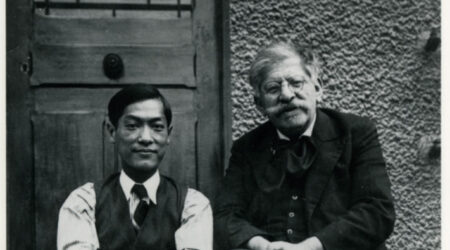How does the opioid overdose crisis reshape rural communities? Through their research on opioid use and opioid-related services in backcountry California, David Showalter argues that an ethnographic sensibility can help us understand how drug use both becomes an ordinary part of people’s lives and what policymakers might do to help prevent overdoses.
David Showalter completed a PhD in Sociology at the University of California, Berkeley in 2022, and is now a postdoctoral fellow in the Sociology Department at Harvard University and will be Assistant Professor of Sociology at Harvard starting in July 2023. David’s research has been published in Social Science and Medicine, Theory and Society, International Journal of Drug Policy, Mobilization, and elsewhere. Outside of their academic work, David previously served as President of the Board of Directors for NEED, a harm reduction services organization in Berkeley.
For this visual interview (an interview accompanied by images or graphs related to a scholar’s research), Matrix Content Curator Julia Sizek spoke with Showalter about trends that have defined the opioid crisis in recent decades.

As noted in this figure, drug-related deaths have been on the rise across the US broadly. What first interested you in studying this topic?
I’ve been working directly with people who use drugs since 2009, when I started volunteering with a harm reduction organization called Chicago Recovery Alliance. At CRA, we distributed supplies like sterile syringes to help people use drugs more safely. We also gave out naloxone, a medication that reverses opioid overdoses.
I had many conversations with people about overdoses they had experienced or witnessed. These stories were heartbreaking and, in most cases, could have been prevented if people had the resources, information, and support to use drugs more safely. Back then, overdose rates were already at record highs, and they continued to climb almost every year since.
By the time I started graduate school in 2013, the opioid overdose crisis was becoming one of the top news stories. I decided to combine my commitments to harm reduction and my social science research skills to better understand the experiences of people at risk of opioid overdose, as well as the policies that could help prevent overdose deaths.
For my dissertation, I conducted a multi-site ethnographic study of opioid use and opioid-related services in California’s remote and mountainous backcountry. In total, I conducted interviews across a dozen counties and did more intensive ethnographic fieldwork in five counties. I interviewed dozens of people who used drugs, health care and treatment providers, and law enforcement officers to understand what it was like to live in isolated places where “everybody knows everybody,” and how drug use and local government were shaped by those surroundings.
I also spent a lot of time hanging out with people as they bought, sold, and used drugs, and with service providers as they planned new programs. Participant-observation research like this helps us see the complexity of people’s lives and avoid reducing them to their drug use.
What I found is that the social intimacy and geographic isolation of small towns affects almost every aspect of everyday life, including drug use. Looking for drugs meant traversing long distances to cities while avoiding law enforcement officers who might know you personally. Using drugs meant scrounging for scarce supplies and avoiding health care providers who might tag you as an “addict.” And quitting drugs could mean leaving home altogether to access treatment or escape a negative reputation.
This seems like it could be a challenging group to research. How did you gain access to this community?
Building trusting and authentic relationships with the people you are studying is key to ethnographic research. It can be difficult for outsiders entering isolated communities to study stigmatized topics like drug use.
However, I found that, by and large, local officials were easy to meet because they recognized opioid use and overdose as issues in their communities and wanted help with addressing them. They appreciated my interest in their communities, and assumed that I must be an expert if I studied at Cal!
Local officials in rural areas were also more accessible to the public: their offices were small and open, and they were personally acquainted with many of their constituents. For example, in one small town, I called to make appointments with the chief of police and other officials and was told to just stop by the next morning whenever I had time.
When it came to meeting people who use drugs, I got lucky a few times by meeting the right people. I met one key individual because they happened to be friends with the person from whom I rented a room.
But what was really important was my experience with harm reduction programs. Throughout graduate school, I was a member of NEED, a volunteer-led harm reduction organization in Berkeley. We distributed new syringes and other equipment, disposed of used syringes, trained people to use naloxone, and gave out other essential health and wellness supplies.
As a result of my work in harm reduction, I was able to communicate with people about their drug use in a knowledgeable and nonjudgmental way. I didn’t assume that they were “addicted,” for example, or that they viewed their drug use as a problem.
I also didn’t exoticize their lives because they did something most people don’t do, nor did I dramatize their drug use as something edgy, spectacular, or rebellious. If you use drugs every day, it’s a pretty mundane part of your life; sometimes it is almost like another chore to complete. I think recognizing the “normality” of drug use in people’s lives helped put them more at ease.
Because I was connected to harm reduction programs, I was also sometimes able to bring people important health supplies, like new syringes to help prevent transmission of diseases like HIV and hepatitis C, biohazard disposal containers to safely dispose of used syringes, and naloxone in case of overdose. By these words and actions, I convinced people that I viewed them with the same respect and care as I did anyone else, rather than with curiosity or suspicion.

In this figure, we can see how rural regions in California, particularly in the northeastern part of the state, have higher rates of opioid use. How has this been explained by scholars, and what did you find in your research?
Researchers studying rural opioid use have highlighted both “supply” and “demand” factors. On the supply side, some rural regions were targeted by opioid companies with intense marketing, and doctors there prescribed opioids at high rates.
On the demand side, rural populations are in overall poorer health and are served by weaker health care systems, making painkillers an attractive solution for overworked health care providers and patients suffering from pain. These trends contributed to increases in the number of people using and dependent on opioids.
As awareness of the crisis grew in the early 2010s, policymakers pushed to restrict prescribing; around the same time, rates of heroin use and overdose increased. Researchers were split on whether people were switching because their dependence was growing or if it was because heroin had become cheaper or easier to get than pills.
One of the reasons I focused on rural California is that it had received much less attention from reporters and researchers than other rural regions, like Appalachia and New England. I wondered whether the stories I had heard about those places would translate to another region.
In my fieldwork, I found that because there were few health care providers, changes in their opioid prescribing practices could have broad and unintended ripple effects. Providers reduced opioid prescriptions out of concern that people might overdose, but some people who depended on those pills didn’t quit and instead sought out alternatives, including heroin.
Media attention has focused on the role that pharmaceutical companies have played in furthering the opioid epidemic. Teva, CVS, Walgreens and other companies in the opioid industry have recently settled or been ordered to pay damages for their roles in the crisis. In your research, you challenge this focus on pharmaceutical companies and instead suggest a different history of the crisis. What did you find?
Pharmaceutical companies did introduce and irresponsibly market powerful opioid medications that significantly contributed to the initial rise in overdose deaths. This included targeting physicians in some rural regions in order to increase opioid prescribing.
But the contemporary overdose crisis was not the beginning of rural opioid use. Morphine and opium first took hold in rural California during the 19th-century Gold Rush, when both were used medicinally and recreationally, and concerns about opioid use cropped up repeatedly in the region during the 20th century. This recurring affinity between opioid and rural places is therefore not solely due to pharmaceutical marketing.
Rather, I found that opioids helped address two important preexisting complaints in these places. First, rural health care systems are understaffed and often lack specialized services, and opioids were an easy solution for health care providers who could not comprehensively address their patients’ health concerns.
Second, rural residents frequently complained of boredom and hopelessness due to economic decline, population loss, and lack of local amenities. Opioids, like other drugs, can distract from these conditions and soothe the negative emotions that they provoke. In short, focusing on the actions of pharmaceutical companies can overshadow the reasons why opioids were so appealing in rural areas to begin with.

As noted in this figure, age-adjusted mortality rates have been higher in rural California. In comparison to cities, what social and medical services are available to rural residents, and how do you think this has shaped the opioid epidemic?
I think about opioid overdose (and other drug-related health problems) in two ways. On the one hand, people risk dying from overdose if the drugs they are using are too potent or too inconsistent for them to accurately gauge their dose and tolerance.
But overdose risk is also shaped by the presence or absence of protective factors, such as harm reduction services that distribute naloxone, and treatment programs that offer medications for opioid use disorder, like methadone and buprenorphine. Historically these services have been much more common and accessible in urban areas.
Harm reduction services grew out of urban social movements and until recently were very scarce in rural areas. For example, when I started my fieldwork in 2017, only a handful of rural counties in California had syringe services programs, and community-based access to naloxone was almost nonexistent in many places.
Substance use treatment services in these counties were also scarce, and were in some cases limited to self-help groups like Alcoholics Anonymous and Narcotics Anonymous. Standard-of-care medications like methadone and buprenorphine were unavailable in many communities due to regulatory requirements and because rural providers were hesitant to offer them.
The absence of these services during the first wave of the overdose crisis meant that it was harder for people in rural areas to use opioids safely and to get help managing or reducing their opioid use.
One of your key contributions is the idea of “acquainted marginality,” which you use to describe how people in small towns have enduring connections. How did these forms of acquainted marginality change how people acted in the local drug scene, as well as with local medical practitioners and service providers?
Acquainted marginality is the condition of being marginalized in your community — by poverty, ethnoracial discrimination, or criminalization, for example — yet personally acquainted with those who exercise power over you: the police, health care providers, or even elected officials. In the small towns I studied, it was common for people who used drugs to know sheriff deputies by name, or even to have grown up with them.
Those personal connections multiplied opportunities for law enforcement to gather information, whether through gossip or direct observation. You risked being seen any time you left your home, or your car could be recognized on the road. And any information you shared with others — or any assumption they made about you — could potentially get back to law enforcement. That made people who used drugs cautious about their movements, and reluctant to engage with health care and other services for fear that they would be marked as an “addict” or even reported to law enforcement.
For some people, this even meant refusing to call 911 in emergencies or go to the hospital for serious health problems. I heard stories of people abandoning their friends who overdosed and watched people treat abscesses at home rather than risk being identified in the emergency room. The intersection of dense social networks and harsh punishment of drug use keeps people from getting the help they want and need.
Most research on drug use within sociology has an urban focus. What do you think a return to rural sociology can bring to the field as a whole?
Rural areas and small towns are important for sociological research for several reasons. First, even in urbanized societies like the United States, significant numbers of people live outside of large cities. Their lives are just as complex and their wellbeing is just as important as anyone else’s, and if we truly mean to study society as a whole, we can’t ignore the full spectrum of human settlements.
I have been struck by how perceptions of “rural Americans” have veered from one stereotype to another in recent years. When I was planning this research in 2016, those I talked with tended to express pity for rural areas that were suffering so-called “deaths of despair.” But in the wake of the Trump Administration, I have heard more contempt for rural Americans, even a feeling that they deserve what they get. In-depth research can help counteract these inaccurate and simplistic images.
Second, studying non-urban areas helps to define the “scope conditions” of our theories, to see whether they apply to all people and places, or only to those that receive the most attention. I found that some aspects of rural drug markets were similar to those in urban areas that have been studied more extensively. For instance, people in small towns have to share money, drugs, and other resources to get by, much like poor urban residents do. But other aspects were much different. While urban police often overlook personal drug use to avoid wasting time on an arrest, people I talked to in small towns received comparatively harsh punishment for offenses as minor as being under the influence of drugs.
Third, small populations in rural areas allow us to study “simplified” versions of social groups, organizations, and interactions that take on more complex forms in larger places, which is useful for thinking about fundamental relationships between place, social structure, and inequality. Whereas in large cities interactions between government agencies and residents are innumerable and highly dispersed, in small towns the connections between officials and their constituents are closer and clearer. For example, it’s easier to see how the behavior of prosecutors and judges affects residents’ views of their courts when there are only one, two, or a few prosecutors and judges making all the decisions.
Finally, social dynamics that may seem distinct to more remote and isolated places can reappear in unexpected ways in urban settings. For instance, the experience of being personally acquainted with influential and powerful members of your community is not unique to small towns, but shows up to varying degrees in segregated neighborhoods, insular subcultures, or organizations like schools, universities, and hospitals. Studying rural areas can therefore also illuminate important aspects of other kinds of settlements as well.
What advice would you have for policymakers who are trying to create policies about opioid abuse?
The story of policy responses to the overdose crisis has been one of tragic unintended consequences. Lax oversight of opioid prescribing exposed vulnerable populations to powerful and potentially deadly drugs. But more recently, crackdowns on prescribing have pushed some people who lose access to pills toward more dangerous substances like heroin and fentanyl. With such a potent and dangerous drug supply, we should be very careful to consider whether policy changes risk leaving people in more dangerous situations than they are in now.
With that in mind, here are three directions I think we need to push to address overdose deaths.
First, we need to universalize harm reduction services to reach people who are currently using drugs — not just basic services like distributing new syringes and naloxone, but also overdose prevention sites, where people can bring their drugs to be rapidly tested for fentanyl and other substances, and can use drugs under trained supervision.
Second, we need to make treatment medications easier to get and more appealing than illicit opioids. This means designing low-barrier, flexible, patient-centered programs that reach people directly in their communities, including through mobile and telehealth services. We also need a wider range of treatment medications to address all patients’ needs, such as heroin and hydromorphone, which are sometimes prescribed for opioid use disorder in Canada.
Third, we need to give people who don’t want or need treatment access to safer alternatives to the increasingly dangerous and unpredictable illicit drug supply. To access treatment and other services, people have to stay alive. Compassion clubs in Canada have demonstrated at a small scale the feasibility of sourcing, testing, and non-commercially distributing pure supplies of heroin and other drugs to people who are dependent on them. These efforts deserve serious attention.



